齐白石英文介绍解析
- 格式:pdf
- 大小:2.23 MB
- 文档页数:13
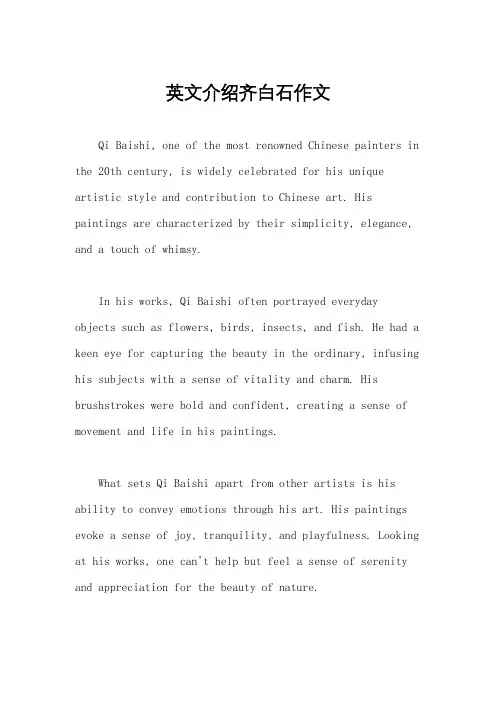
英文介绍齐白石作文Qi Baishi, one of the most renowned Chinese painters in the 20th century, is widely celebrated for his unique artistic style and contribution to Chinese art. His paintings are characterized by their simplicity, elegance, and a touch of whimsy.In his works, Qi Baishi often portrayed everyday objects such as flowers, birds, insects, and fish. He had a keen eye for capturing the beauty in the ordinary, infusing his subjects with a sense of vitality and charm. His brushstrokes were bold and confident, creating a sense of movement and life in his paintings.What sets Qi Baishi apart from other artists is his ability to convey emotions through his art. His paintings evoke a sense of joy, tranquility, and playfulness. Looking at his works, one can't help but feel a sense of serenity and appreciation for the beauty of nature.Qi Baishi's artistic style is also characterized by his use of vibrant colors. He often employed a limited color palette, using bold and contrasting hues to create visual impact. His use of color adds depth and dimension to his paintings, making them visually captivating and memorable.Another notable aspect of Qi Baishi's art is his use of symbolism. He often incorporated symbolic elements in his paintings, such as peaches, which represent longevity, and fish, which symbolize abundance and prosperity. These symbols add layers of meaning to his works, making them not only visually appealing but also thought-provoking.Qi Baishi's influence on Chinese art cannot be overstated. His unique style and artistic vision have inspired countless artists and continue to resonate withart lovers around the world. His paintings are a testament to the power of art to capture the essence of life and bring joy to those who appreciate it.In conclusion, Qi Baishi's art is a delightful blend of simplicity, elegance, and whimsy. His ability to infuseeveryday objects with vitality and convey emotions through his brushstrokes is truly remarkable. His use of vibrant colors and symbolic elements adds depth and meaning to his paintings. Qi Baishi's art continues to captivate and inspire audiences, making him a true master of Chinese painting.。
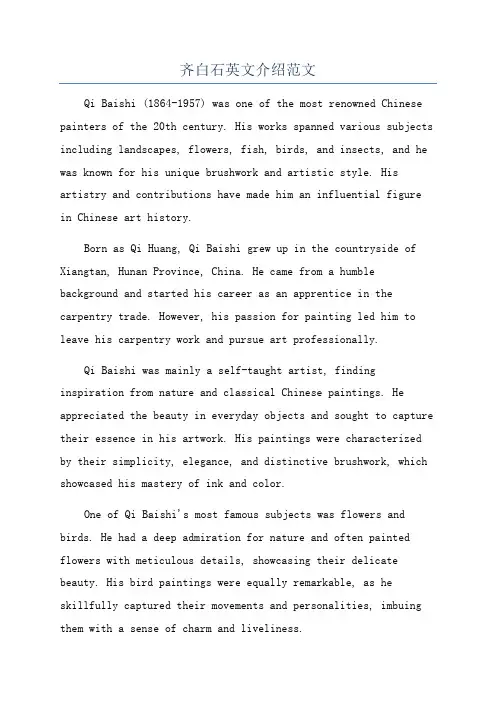
齐白石英文介绍范文Qi Baishi (1864-1957) was one of the most renowned Chinese painters of the 20th century. His works spanned various subjects including landscapes, flowers, fish, birds, and insects, and he was known for his unique brushwork and artistic style. His artistry and contributions have made him an influential figurein Chinese art history.Born as Qi Huang, Qi Baishi grew up in the countryside of Xiangtan, Hunan Province, China. He came from a humble background and started his career as an apprentice in the carpentry trade. However, his passion for painting led him to leave his carpentry work and pursue art professionally.Qi Baishi was mainly a self-taught artist, finding inspiration from nature and classical Chinese paintings. He appreciated the beauty in everyday objects and sought to capture their essence in his artwork. His paintings were characterized by their simplicity, elegance, and distinctive brushwork, which showcased his mastery of ink and color.One of Qi Baishi's most famous subjects was flowers and birds. He had a deep admiration for nature and often painted flowers with meticulous details, showcasing their delicate beauty. His bird paintings were equally remarkable, as he skillfully captured their movements and personalities, imbuing them with a sense of charm and liveliness.Apart from flowers and birds, Qi Baishi also painted landscapes, fish, insects, and other subjects. His landscape paintings were characterized by their strong brushstrokes and simplified forms, which demonstrated his ability to convey a sense of tranquility and harmony. He was also known for his fish paintings, which were vibrant and lively, capturing the spirit of these aquatic creatures.Qi Baishi's artwork has received widespread recognition and acclaim. He was awarded numerous honors and prizes throughout his career, including the title of "People's Artist" given to him by the Chinese government in 1953. His paintings have been exhibited in major museums and galleries around the world and have fetched high prices in auctions.Qi Baishi's artistic legacy lives on, and his influence can still be felt in the contemporary art scene. His innovative techniques, unique style, and profound appreciation for nature continue to inspire artists globally. His artworks serve as a bridge between traditional Chinese art and modern artistic expression, making him a revered figure in the art world.。
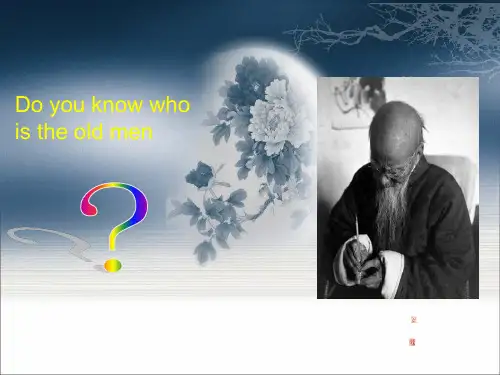

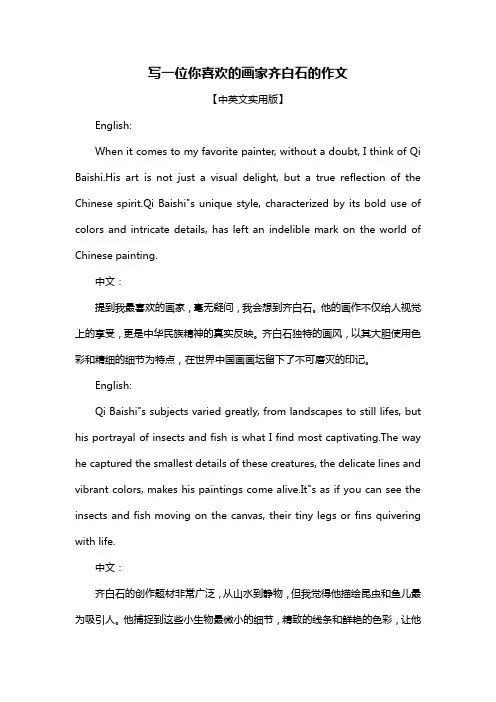
写一位你喜欢的画家齐白石的作文【中英文实用版】English:When it comes to my favorite painter, without a doubt, I think of Qi Baishi.His art is not just a visual delight, but a true reflection of the Chinese spirit.Qi Baishi"s unique style, characterized by its bold use of colors and intricate details, has left an indelible mark on the world of Chinese painting.中文:提到我最喜欢的画家,毫无疑问,我会想到齐白石。
他的画作不仅给人视觉上的享受,更是中华民族精神的真实反映。
齐白石独特的画风,以其大胆使用色彩和精细的细节为特点,在世界中国画画坛留下了不可磨灭的印记。
English:Qi Baishi"s subjects varied greatly, from landscapes to still lifes, but his portrayal of insects and fish is what I find most captivating.The way he captured the smallest details of these creatures, the delicate lines and vibrant colors, makes his paintings come alive.It"s as if you can see the insects and fish moving on the canvas, their tiny legs or fins quivering with life.中文:齐白石的创作题材非常广泛,从山水到静物,但我觉得他描绘昆虫和鱼儿最为吸引人。
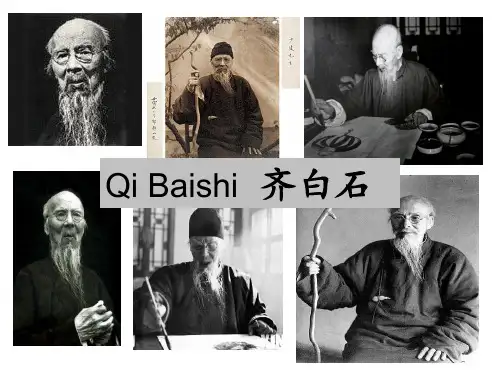
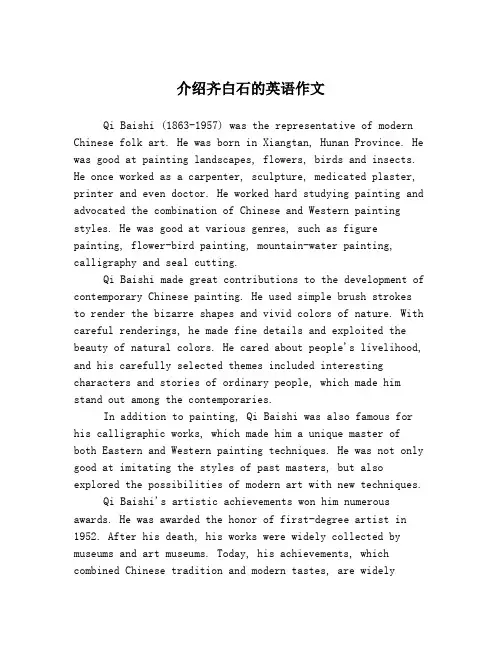
介绍齐白石的英语作文Qi Baishi (1863-1957) was the representative of modern Chinese folk art. He was born in Xiangtan, Hunan Province. He was good at painting landscapes, flowers, birds and insects. He once worked as a carpenter, sculpture, medicated plaster, printer and even doctor. He worked hard studying painting and advocated the combination of Chinese and Western painting styles. He was good at various genres, such as figure painting, flower-bird painting, mountain-water painting, calligraphy and seal cutting.Qi Baishi made great contributions to the development of contemporary Chinese painting. He used simple brush strokesto render the bizarre shapes and vivid colors of nature. With careful renderings, he made fine details and exploited the beauty of natural colors. He cared about people's livelihood, and his carefully selected themes included interesting characters and stories of ordinary people, which made him stand out among the contemporaries.In addition to painting, Qi Baishi was also famous for his calligraphic works, which made him a unique master of both Eastern and Western painting techniques. He was not only good at imitating the styles of past masters, but also explored the possibilities of modern art with new techniques.Qi Baishi's artistic achievements won him numerous awards. He was awarded the honor of first-degree artist in 1952. After his death, his works were widely collected by museums and art museums. Today, his achievements, which combined Chinese tradition and modern tastes, are widelyrespected, and his art is still influential all over the world.。
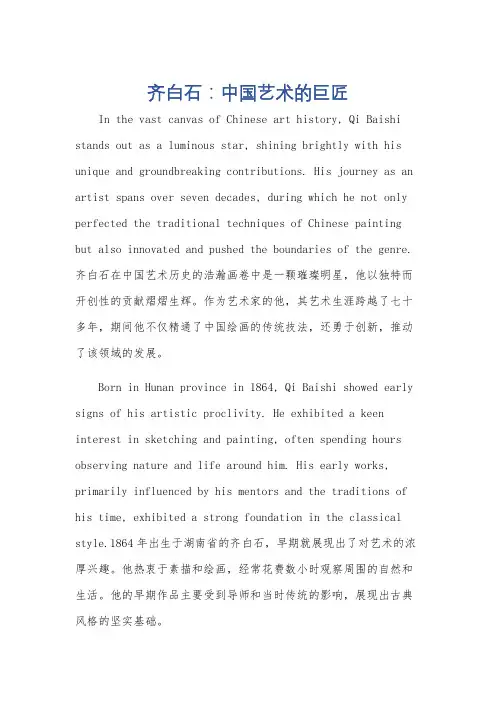
齐白石:中国艺术的巨匠In the vast canvas of Chinese art history, Qi Baishi stands out as a luminous star, shining brightly with his unique and groundbreaking contributions. His journey as an artist spans over seven decades, during which he not only perfected the traditional techniques of Chinese painting but also innovated and pushed the boundaries of the genre.齐白石在中国艺术历史的浩瀚画卷中是一颗璀璨明星,他以独特而开创性的贡献熠熠生辉。
作为艺术家的他,其艺术生涯跨越了七十多年,期间他不仅精通了中国绘画的传统技法,还勇于创新,推动了该领域的发展。
Born in Hunan province in 1864, Qi Baishi showed early signs of his artistic proclivity. He exhibited a keen interest in sketching and painting, often spending hours observing nature and life around him. His early works, primarily influenced by his mentors and the traditions of his time, exhibited a strong foundation in the classical style.1864年出生于湖南省的齐白石,早期就展现出了对艺术的浓厚兴趣。
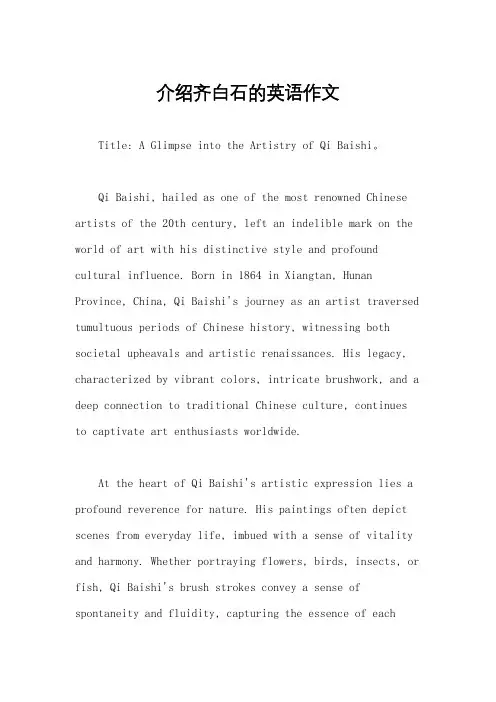
介绍齐白石的英语作文Title: A Glimpse into the Artistry of Qi Baishi。
Qi Baishi, hailed as one of the most renowned Chinese artists of the 20th century, left an indelible mark on the world of art with his distinctive style and profound cultural influence. Born in 1864 in Xiangtan, Hunan Province, China, Qi Baishi's journey as an artist traversed tumultuous periods of Chinese history, witnessing both societal upheavals and artistic renaissances. His legacy, characterized by vibrant colors, intricate brushwork, and a deep connection to traditional Chinese culture, continues to captivate art enthusiasts worldwide.At the heart of Qi Baishi's artistic expression lies a profound reverence for nature. His paintings often depict scenes from everyday life, imbued with a sense of vitality and harmony. Whether portraying flowers, birds, insects, or fish, Qi Baishi's brush strokes convey a sense of spontaneity and fluidity, capturing the essence of eachsubject with remarkable precision. His mastery of the "gongbi" and "xieyi" techniques, representing meticulous detail and expressive freedom, respectively, showcases his versatility and artistic prowess.One of Qi Baishi's most iconic motifs is the humble shrimp. In his paintings, shrimp symbolize resilience, perseverance, and the beauty of simplicity. Through subtle variations in brushwork and shading, Qi Baishi infuses these small crustaceans with life-like vitality, elevating them from mere subjects to embodiments of profound philosophical ideals. His shrimp paintings, characterized by intricate detailing and dynamic compositions, epitomize his ability to transform the ordinary into the extraordinary.Beyond his technical skill, Qi Baishi's artistry reflects his deep spiritual connection to Chinese culture and tradition. Influenced by Daoist philosophy and Confucian ethics, his works often convey moral lessons and philosophical insights. Through allegorical imagery and symbolic motifs, Qi Baishi imparts timeless wisdom,inviting viewers to contemplate the beauty of nature and the transient nature of existence. His art serves as a bridge between past and present, preserving ancient wisdom in a modern context.In addition to his traditional Chinese paintings, Qi Baishi was also a master of calligraphy. His elegant brushwork and graceful strokes earned him widespread acclaim as a calligrapher, further solidifying his status as a multifaceted artistic genius. Whether conveying poetic verses or philosophical aphorisms, Qi Baishi's calligraphy embodies the essence of Chinese literary tradition, demonstrating a deep appreciation for the written word as an art form.Qi Baishi's influence extends far beyond the realm of art, encompassing politics, education, and cultural exchange. Throughout his life, he remained deeply committed to promoting traditional Chinese culture and fostering artistic innovation. His role as a cultural ambassador earned him accolades both at home and abroad, solidifying his legacy as a global icon of Chinese art.In conclusion, Qi Baishi's artistic legacy continues to inspire and enchant audiences worldwide. Through his mastery of brush and ink, he captured the beauty of nature and the essence of Chinese culture with unparalleled skill and grace. As we reflect on his life and work, we are reminded of the enduring power of art to transcend boundaries and unite humanity in appreciation of beauty and creativity.。
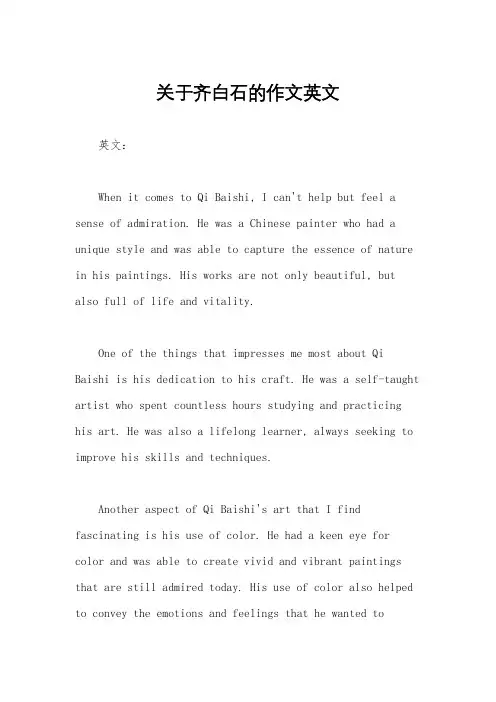
关于齐白石的作文英文英文:When it comes to Qi Baishi, I can't help but feel a sense of admiration. He was a Chinese painter who had a unique style and was able to capture the essence of nature in his paintings. His works are not only beautiful, but also full of life and vitality.One of the things that impresses me most about Qi Baishi is his dedication to his craft. He was a self-taught artist who spent countless hours studying and practicing his art. He was also a lifelong learner, always seeking to improve his skills and techniques.Another aspect of Qi Baishi's art that I find fascinating is his use of color. He had a keen eye forcolor and was able to create vivid and vibrant paintings that are still admired today. His use of color also helped to convey the emotions and feelings that he wanted toexpress in his art.Finally, I appreciate how Qi Baishi was able to infuse his paintings with a sense of humor and playfulness. Heoften included animals and other whimsical elements in his works, which added a lighthearted touch to his art.中文:提到齐白石,我就忍不住感到一种敬佩之情。
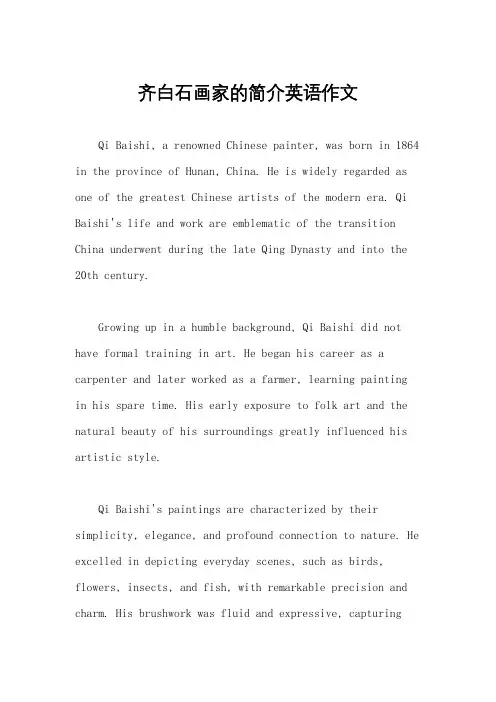
齐白石画家的简介英语作文Qi Baishi, a renowned Chinese painter, was born in 1864 in the province of Hunan, China. He is widely regarded as one of the greatest Chinese artists of the modern era. Qi Baishi's life and work are emblematic of the transition China underwent during the late Qing Dynasty and into the 20th century.Growing up in a humble background, Qi Baishi did not have formal training in art. He began his career as a carpenter and later worked as a farmer, learning paintingin his spare time. His early exposure to folk art and the natural beauty of his surroundings greatly influenced his artistic style.Qi Baishi's paintings are characterized by their simplicity, elegance, and profound connection to nature. He excelled in depicting everyday scenes, such as birds, flowers, insects, and fish, with remarkable precision and charm. His brushwork was fluid and expressive, capturingthe essence of his subjects with a sense of vitality and spontaneity.One of Qi Baishi's most notable contributions to Chinese art is his innovative approach to traditional Chinese painting techniques. He combined elements of classical ink painting with a more personal and experimental style, resulting in works that were both timeless and contemporary.Throughout his life, Qi Baishi remained deeply rootedin Chinese cultural traditions while embracing new ideas and influences. He was known for his humility, generosity, and dedication to his craft. Despite facing numerous hardships and setbacks, including political upheaval and personal tragedies, Qi Baishi continued to paint with passion and perseverance.In addition to his artistic achievements, Qi Baishi was also a respected calligrapher and seal carver. His mastery of these disciplines further enriched his artistic practice and earned him widespread acclaim.Qi Baishi's influence extended far beyond the realm of art. He was a beloved figure in Chinese society, reveredfor his artistic talent, moral integrity, and commitment to preserving Chinese cultural heritage. His legacy continues to inspire artists and admirers around the world, reaffirming his status as one of the preeminent figures in the history of Chinese art.。
我最喜欢的画家齐白石英语作文Qi Baishi: The Quintessential Chinese PainterQi Baishi, a renowned Chinese painter, has long been revered as one of the most influential and celebrated artists of the 20th century. His unique style, which seamlessly blends traditional Chinese painting techniques with a modern sensibility, has captivated art enthusiasts around the world. As one of my personal favorite painters, Qi Baishi's work has left an indelible mark on me, inspiring me to delve deeper into the rich tapestry of Chinese art and culture.Born in 1864 in Xiangtan, Hunan Province, Qi Baishi's artistic journey began at a young age when he was exposed to the traditional art forms of his local community. From an early age, he demonstrated a natural talent for painting, and his keen observation of the natural world around him would later become the foundation of his distinctive style. Hailing from a humble background, Qi Baishi's early life was marked by adversity, but it was during these formative years that he developed a deep appreciation for the beauty and simplicity of everyday objects and scenes.One of the most striking aspects of Qi Baishi's work is his mastery ofthe xieyi style, a technique that emphasizes the spontaneous and expressive rendering of subjects. Rather than focusing on the meticulous rendering of details, Qi Baishi's paintings capture the essence of his subjects through bold brushstrokes and a keen eye for composition. This approach, which was heavily influenced by the works of the Ming and Qing dynasty masters, allowed him to imbue his paintings with a sense of energy and dynamism that is truly captivating.Another hallmark of Qi Baishi's art is his fascination with the natural world. From delicate flowers and insects to rugged landscapes and wildlife, his paintings celebrate the beauty and diversity of the natural environment. His keen observation of the natural world, combined with his technical prowess, allowed him to create works that are both visually stunning and emotionally evocative. Whether he was depicting the graceful movements of a crab or the weathered texture of a rock, Qi Baishi's paintings possess a level of realism and attention to detail that is truly remarkable.One of the most remarkable aspects of Qi Baishi's work is his ability to convey a sense of humor and playfulness. Many of his paintings feature whimsical and lighthearted depictions of everyday objects and scenes, reflecting his own joyful and optimistic outlook on life. This playful spirit is particularly evident in his paintings of animals, where he often imbues his subjects with a sense of personality andcharacter that is both charming and endearing.Despite his immense talent and recognition, Qi Baishi remained a humble and unassuming artist throughout his life. He was known for his generosity and kindness, often mentoring younger artists and sharing his knowledge and techniques with them. This spirit of generosity and humility is reflected in his paintings, which convey a sense of warmth and accessibility that resonates with viewers of all backgrounds.As I continue to study and appreciate Qi Baishi's work, I am struck by the depth and complexity of his artistic vision. His paintings not only showcase his technical mastery but also his profound understanding of the human experience and the natural world. Whether he was depicting the delicate beauty of a flower or the rugged grandeur of a mountain, Qi Baishi's work always manages to touch the heart and soul of the viewer.In conclusion, Qi Baishi's legacy as one of China's most celebrated artists is a testament to the enduring power of art to transcend cultural boundaries and connect people across time and space. His work has inspired me to explore the rich and diverse world of Chinese art and culture, and I am grateful for the opportunity to study and appreciate the brilliance of this truly remarkable painter.。
齐白石英文作文素材英文:When it comes to the great Chinese painter Qi Baishi, I am filled with admiration and awe. His paintings are not only beautiful, but also full of life and personality. In my opinion, his ability to capture the essence of his subjects is what sets him apart from other artists.One of my favorite examples of Qi Baishi's work is his painting of a shrimp. At first glance, it may seem like a simple and unremarkable subject, but the way he paints itis truly incredible. He uses a variety of brushstrokes to create a sense of movement and texture, and the colors he chooses are so vibrant and full of life.Another thing I admire about Qi Baishi is his dedication to his craft. He continued to paint well into his old age, and even when he was blind, he would have his students describe the scenes he wanted to paint so that hecould create them in his mind's eye. This kind of perseverance and passion is truly inspiring.中文:提到伟大的中国画家齐白石,我充满了敬仰和敬畏之情。
齐白石英文简介齐白石,近现代中国绘画大师,世界文化名人。
曾任中央美术学院名誉教授、中国美术家协会主席等职。
下面是店铺为你整理的齐白石英文简介,希望对你有用!齐白石简介Qi Baishi (January 1, 1864 - September 16, 1957), native of Anhui Province, Dangshan, was born in Changsha, Hunan Xiangtan (now Hunan Xiangtan).Formerly known as pure Chi, the word Wei, No. Lanting. After renamed Juan, the word end of life, No. Whitehead, Whitehead Hill Weng, old Ping, hungry old man, by the mountain Yin Museum Lord, send Ping Tong old man, three hundred stone inscriptions.Is a modern Chinese painting master, world cultural celebrity. Early years for the carpentry, after the painting for a living, after the age of fifty-five settled in Beijing. Good at flowers and birds, insect fish, landscapes, figures, ink vigorous moisturizing, bright colors bright and bright, simple and vivid shape, the mood is simple and honest. Made fish and shrimp insect crab, days interesting.Qi Baishi book seal, take the seal in the Qin and Han Dynasties, the book Rao ancient Zhuo of interest, seal a self, a good writing poetry. Former honorary professor of the Central Academy of Fine Arts, chairman of the Chinese Artists Association and other staff. Representative of the "frog ten miles out of the spring" "shrimp" and so on. Author of "Whitehead poetry grass" "White stone old man read" and so on.齐白石生平经历January 1, 1864 (lunar calendar year in 1863 winter twenty-two days), Qi Baishi was born in Changsha, Hunan Xiang Xiangtan white stone shop apricot dock star dish pond. Name pure Chi, the word Wei Qing, and word Lanting. 27-year-old renamed Juan, word frequency students, alias white stone mountain people, and also send garden.In 1870, from the grandfather Zhou Yu if reading, commonly used books, books thin paper painting.In 1878, thanks to the United States as a teacher to learn carved carpenter. Do carpentry, to the residual "mustard garden" as a teacher, learning flowers and birds, figure painting.In 1888, thanks to folk artists Xiao Xiang 陔 portrait for the teacher painting.In 1889, thanks to Hu Patio, Chen Shao Fan as a teacher poetry, was Hu Qinyuan help, from the woodworker life, study painting, portrait for the family.In 1894, and Wang Zhongyan and other seven knot "Longshan Poetry Society", was elected president. And after Li Songan Temple and other knot "Luoshan Poetry Society", together with poetry, painting, carved stone.In 1899, thanks to Xiangtan celebrities Wang Kaiyun as a teacher to learn poetry. With the first annual publication of the printed map "send garden printed", printing Ding Jing, Huang Yi, sophisticated rules, can be true.In 1900, living in the lotus peak under the Mei Gongci, claiming to "Bai Mei book house", and in the hospital built a small house, the name "by the mountain museum." Committed to painting, poetry.In 1902, at the invitation of Xia Yi Yi, went to Xi'an to teach. In Xi'an to get to know Fan Fan Shan, do the view of the possession of eight mountains, Jinnong and other famouspainting and calligraphy. Is the year, the flowers and birds of a unique style, embarked on a freehand painting path.In 1903, from Xi'an to Beijing, met Zeng Xi, Li Ruquan, etc., during the summer afternoon Yi Yi proposed to the Empress Dowager Cixi recommended Qi Baishi to do the inner court, Summer, from Beijing to Shanghai, back to Hunan, this is the "five out of five" for the first time travel.In 1904, with Wang Kaiyun went to Jiangxi, travel Lushan, Nanchang and other places, published "white stone grass clothing character carved", Wang Kaiyun for its order.In 1905, went to Guangxi, tour Guilin. And Cai E, Huang Xing acquaintance.In 1906, after the Spring Festival, Wuzhou by the Guangzhou to Qinzhou, Guo Baosheng left its teaching. Enjoy the possession of Guo Xu Wei, eight, Jinnong famous authentic. Work with paintings, during which often Guo Dai pen. Autumn, back to Xiangtan, to teach painting salary to buy the old house and dozens of acres of paddy fields.1907, the spring and summer of the turn, then go to Qinzhou, tour Zhaoqing, Duanxi. Winter, back to Xiangtan.In 1908, spring went to Guangzhou. Is the year, only to live back to Xiangtan a few days, the rest of the time spent in Guangzhou.In 1909, after the Spring Festival in Guangzhou, after Qinzhou. Early summer to Shanghai, to sell paintings for a living. Between summer and autumn, travel Suzhou. To visit Nanjing Li Meiyan, for its governance tripartite. October return to Xiangtan, thus ending the "five out of five" travel far life. Then in the home repair "send Ping Church", began 8 years of mountain life, painstakingly painted poetry. On the eight mountain people,stone Tao flowers and more paintings, the brush more concise, but the grass insects sketch, more work, or to write out of the free. Calligraphy learn gold farmers, get their marrow.In 1917, to avoid the bandits to Beijing. Is to catch up with "Zhang Xun restoration", rush to Tianjin asylum. The situation is slightly scheduled, return to Beijing, in the glass factory south of the paper shop hanging Runge painting. Period and old friends Fan Fan Shan, Xia Wu Yi, Guo Baosheng and other contacts very close. And meet Chen Shizeng, Yao Mang father, Chen and so on. Which has been set with Chen Shi, Qi Bai Shi had a great impact on old age. Is the winter, leaving Beijing to return to Hunan, rural one year.In 1919, married with Hu Baozhu, from Beijing.In 1923, Chen Shi had died in Nanjing, several times poems mourning friends. 1925, spring, serious illness, personnel do not know seven days and nights. Waiting for more than a month, stop painting, engraved. Mei Lanfang officially apprenticeship painting.In 1926, the mother and father died one after another. Twice to stop painting, engraved.In 1927, at the invitation of Lin Fengmian, taught at the Beijing Art College.1928, the printing of "white stone poetry grass" "by the mountain museum poetry grass" (handwritten copy) 1933, printed "white stone poetry grass" (eight volumes of printed)1936, travel Sichuan. In the Chuan know Huang Binhong.In 1937, listen to Changsha Shu Yi on the fortune-telling said, with the deceived, since the 77-year-old. In July, Peiping fall, feeling grievous, easy to see customers.In 1940, the lunar month, his wife died in Chen Junchun, wrote "Lady Chen" text. To resist the Japanese and traitors harassment cable painting, posted "painting does not sell and official home" confession, declined to see customers.In 1944 January, following the room Hu Baozhu died. In June, refused to Peiping Art assigned to coal.In 1946, the end of the war, complex and then in the glass factory hanging Runge, restore the sale of engraving. In October, go to Nanjing, Shanghai to do the exhibition, more than 200 paintings all sold, bring back a bundle of "French", as waste paper, actually can not buy 10 bags of flour.In January 1949, Beiping liberated. To attend the premier reception of Chou Enlai. For Mao Zedong carved stone two sides. As honorary professor of the Central Academy of Fine Arts.In 1950, he was hired as a librarian. In April, had dinner with Mao Zedong, Zhu De to accompany. In October, the 82-year-old made the "eagle" and seal book couplet "sea for the dragon world, the cloud is the crane home" presented Mao Zedong. T o participate in the Beijing "anti-Korean aid painting and calligraphy exhibition". Winter, for the "People's Daily" painting "peace dove" In February 1951, more than 10 paintings to participate in Shenyang City, "the Korean War Painting and Calligraphy Exhibition".In 1952, with three days, for the Beijing Asia-Pacific Regional Peace Conference to create a huge two "white and peace dove." In the same year, many works entitled "Peace Victory" and "Peaceful Long Live".January 7, 1953, Beijing cultural and art circles more than 200 people to participate in "Qi Baishi 90 birthday celebration", the Ministry of Culture awarded Qi Baishi outstanding people artisttitle. Zhou Enlai attended the evening celebration banquet. Served as chairman of the Beijing Chinese Painting Research Association in October, was elected chairman of the first Chinese Artists Association Council.April 28, 1954, the Chinese Artists Association in the Palace Museum held "Qi Baishi painting exhibition" in August, was elected to the National People's Congress. September 15, attended the first National People's Congress.June 1955, and Chen Min Ding, He Xiangning and other 14 painters for the World Peace Assembly cooperation huge "peace"April 27, 1956, the World Peace Council announced the grant of Qi Baishi International Peace Prize, September 1, held a grand ceremony in Beijing. Premier Zhou Enlai personally congratulated.May 15, 1957, served as honorary president of Beijing Chinese Painting Academy. 5 - June, for the last piece of work "Peony". September 16, died at the Beijing hospital. September 22 morning in Jiaxing Temple held a public offering, Premier Zhou Enlai and other central leaders participated in the public offering.In 1963, Qi Baishi was selected as one of the world's top ten cultural celebrities. (Note: the network confirmed that the world's top ten cultural celebrities and no Qi Baishi, the world's top ten cultural celebrities: Confucius, Plato, Aristotle, Copernicus, Newton, Darwin, Bacon, Aquinas, Voltaire, Kant.)。